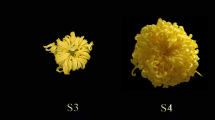Abstract
Carotenoids from the leaves of the common box,Buxus sempervirens (Buxaceae), which turn red in late autumn to winter, were analyzed by reversed-phase HPLC. A novel carotenoid, monoanhydroeschscholtzxanthin (3), was isolated from the red-colored leaves. UV-VIS, MS,1H-NMR and CD spectral data showed that the structure of 3 was (3S)-2′, 3′, 4′, 5′-tetradehydro-4, 5′-retro-β, β-caroten-3-ol. As well as anhydroeschscholtzxanthin (2), the major red carotenoid in the leaves, eschscholtzxanthin (4) was identified. Very small amounts of yellow carotenoids (neoxanthin, violaxanthin, lutein and β-carotene), which are major components of green leaves, were present in the red-colored leaves. The amounts of chlorophylla andb in the leaves decreased markedly during coloration, even at the early stages, whereas those of the yellow carotenoids decreased gradually. In contrast, the content of 2, a red carotenoid, increased steadily during coloration. The biosynthetic pathway of 2 inB. sempervirens was deduced tentatively on the basis of the individual carotenoid contents during autumnal coloration.
Similar content being viewed by others
Abbreviations
- HPLC:
-
high performance liquid chromatography
- UV-VIS:
-
ultraviolet-visible light absorption spectra
- MS:
-
mass spectra
- 1H-NMR:
-
proton-nuclear magnetic resonance
- CD:
-
circular dichroism spectra
- EI-MS:
-
electron impact-mass spectra
- NOE:
-
nuclear Overhauses effect
References
Andrewes, A.G., Borch, G., Strain, H.H. andLiaaen-Jensen, S. 1979. Absolute configuration of eschscholtzxanthin. Phytochemistry18: 303–309.
Costes, C. 1969. Sur la presence d'anhydroeschscholtzxanthin dans les feuilles rouges de buis,Buxus sempervirens. Bull. Soc. Franc. Physiol. Veget.15: 55–77.
Czeczuga, B. 1986. Carotenoids in gymnosperms. Biochem. Syst. Ecol.14: 13–15.
Czeczuga, B. 1987. Different rhodoxanthin contents in the leaves of gymnosperms grown under various light intensities. Biochem. Syst. Ecol.15: 531–533.
Davies, B.H. 1976. Carotenoids.In T.W. Goodwin, ed., Chemistry and Biochemistry of Plant Pigment. Academic Press, New York, 2nd ed., Vol. 2, pp. 38–165.
Demmig-Adams, B. 1990. Carotenoids and photoprotection in plants: a role for xanthophyll zeaxanthin. Biochim. Biophys. Acta1020: 1–24.
Englert, G. andVecchi, M. 1982. High-performance liquid chromatographic separation and proton nuclear magnetic resonance identification of the 6-mono-cis and 6, 6′-di-cis isomers of rhodoxanthin. J. Chromatogr.235: 197–203.
Hayashi, K. andAbe, Y. 1955. Studien über Anthocyane. XXVII. Papierchromatographische übersicht der Anthocyane in Pflanzenreich (II). Farbstoffe des roten Herbstlaubes. Bot. Mag. Tokyo68: 299–307.
Ida, K. 1981. Eco-physiological studies on the response of Taxodiaceous conifers to shading with pecial reference to the behavior of leaf pigments. I. Distribution of carotenoids in green and autumnal reddish brown leaves of gymnosperms. Bot. Mag. Tokyo94: 41–54
Ida, K., Saito, F. andTakeda, S. 1991. Isomers of rhodoxanthin in reddish brown leaves of gymnosperms and effect of daylight intensity on the contents of pigments during autumnal coloration. Bot. Mag. Tokyo104: 157–169.
Karrer, P. andLeumann, E. 1951. Eschscholtzxanthin und Anhydroeschscholtzxanthin. Helve. Chim. Acta34: 445–453.
Koiwa, H., Ikeda, T. andYoshida, Y. 1986. Reversal of chromoplasts to chloroplasts inBuxus Leaves. Bot. Mag. Tokyo99: 233–240.
Lichtenthaler, H.K. 1987. Chlorophylls and carotenoids: pigments of photosynthetic biomembranes. Methods Enzymol.148: 350–382.
Masamoto, K., Kinoshita, T. andShimazaki, K. 1993. Light-induced de-epoxidation of violaxanthin in guard cells ofVicia faba. Plant Cell Physiol.34: 935–938.
Nicoara, E., Tamas, V., Neamtu, G. andBodea, C. 1966. Zur Kenntnis der IR-Spektren vonretro-Dehydrocarotinoiden. Liebigs Annln. Chem.697: 201–203
Rivas, J.D.L., Abadia, A. andAbadia, J. 1989. A new reversed-phase HPLC method resolving all major higher plant photosynthetic pigments. Plant Physiol.91: 190–192.
Strain, H.H. 1938. Eschscholtzxanthin; a new xanthophyll from the petals of the California poppy,Eschscholtzia california. J. Biol. Chem.123: 425–437.
Thayer, S. andBjörkman, O. 1990. Leaf xanthophyll content and composition in sun and shade determined by HPLC. Photosynth. Res.23: 331–323.
Toyama, S. andFunazaki, K. 1971. Electron microscope studies on the morphogenesis of plastids. V. Concerning one-dimensional metamorphosis of the plastids inCryptomeria leaves. Bot. Mag. Tokyo84: 123–136.
Williams, R.J.H., Britton, G. andGoodwin, T.W. 1966. A possible mechanism for the biosynthesis of eschscholtzxanthin. Biochim. Biophys. Acta124: 200–203.
Author information
Authors and Affiliations
Rights and permissions
About this article
Cite this article
Ida, K., Masamoto, K., Maoka, T. et al. The leaves of the common box,Buxus sempervirens (Buxaceae), become red as the level of a red carotenoid, anhydroeschscholtzxanthin, increases. J. Plant Res. 108, 369–376 (1995). https://doi.org/10.1007/BF02344362
Received:
Accepted:
Issue Date:
DOI: https://doi.org/10.1007/BF02344362




